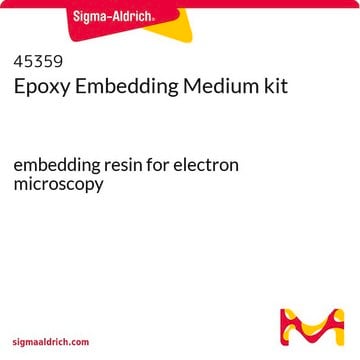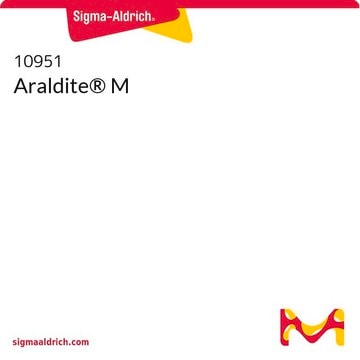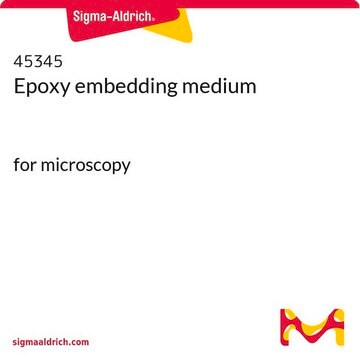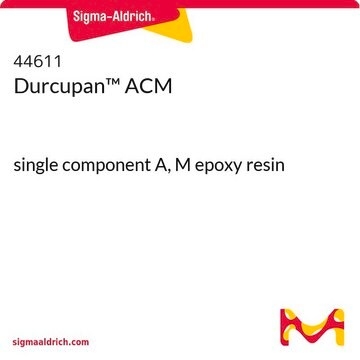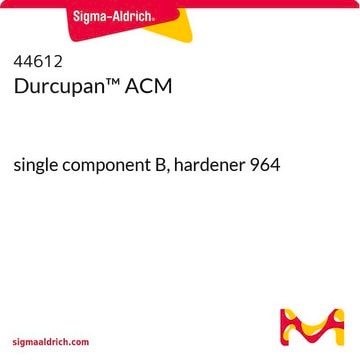10952
Araldite® M Beschleuniger 960
accelerator DY 060
Anmeldenzur Ansicht organisationsspezifischer und vertraglich vereinbarter Preise
Alle Fotos(1)
About This Item
UNSPSC-Code:
41116121
Empfohlene Produkte
Allgemeine Beschreibung
Araldite is an epoxy resin commonly used for embedding. It is basically free from polymerization damage and the plastic does not sublime in the microscope, hence providing continual support and preservation of fine detail. It is composed of araldite M or CY 212, dodecenyl succinic anhydride, dibutyl phthalate and 2,4,6-tridimethylamine methyl phenol.
Anwendung
Araldite® was used to study electrochemical detection of dopamine and ascorbic acid neurotransmitters focusing on miniaturization of a graphite-epoxy and synthetic zeolite-modified graphite-epoxy composite macroelectrode as a quasi-microelectrode. It was also used in production of microfluidic chips using extremely low cost chemicals and equipment which was validated by producing monodisperse polymeric microparticles for drug delivery and hydrogel microfibers for cell embedding.
Rechtliche Hinweise
Araldite is a registered trademark of Huntsman Advanced Materials Inc.
Signalwort
Warning
H-Sätze
Gefahreneinstufungen
Acute Tox. 4 Oral - Eye Irrit. 2 - Skin Irrit. 2
Lagerklassenschlüssel
10 - Combustible liquids
WGK
WGK 3
Flammpunkt (°F)
Not applicable
Flammpunkt (°C)
Not applicable
Persönliche Schutzausrüstung
Eyeshields, Faceshields, Gloves, type ABEK (EN14387) respirator filter
Choose from one of the most recent versions:
Besitzen Sie dieses Produkt bereits?
In der Dokumentenbibliothek finden Sie die Dokumentation zu den Produkten, die Sie kürzlich erworben haben.
Simultaneous/selective detection of dopamine and ascorbic acid at synthetic zeolite-modified/graphite-epoxy composite macro/quasi-microelectrodes.
Ilinoiu EC
Sensors, 13 (6), 7296-7307 (2013)
S Focaroli et al.
Lab on a chip, 14(20), 4007-4016 (2014-08-22)
The present paper describes the production of microfluidic chips using an approach based on shrinkable biocompatible polymers (i.e. agarose) for the production of size controlled microfluidic channels. In addition, all steps of chip production were carried out using an inexpensive
Astrid M Parsons et al.
Dalton transactions (Cambridge, England : 2003), 48(29), 10945-10952 (2019-06-06)
The active fragment [Tp'Rh(CNneopentyl)], generated from the precursor Tp'Rh(CNneopentyl)(PhN[double bond, length as m-dash]CNneopentyl), underwent oxidative addition of substituted ketones and esters resulting in Tp'Rh(CNneopentyl)(R)(H) complexes (Tp' = tris-(3,5-dimethylpyrazolyl)borate). These C-H activated complexes underwent reductive elimination at varying temperatures (24-70 °C)
In Situ Hybridization in Electron Microscopy.
Morel G
Science, 174-175 (2001)
Biological Techniques.
Yadav P.R.
Science, 79-80 (2006)
Unser Team von Wissenschaftlern verfügt über Erfahrung in allen Forschungsbereichen einschließlich Life Science, Materialwissenschaften, chemischer Synthese, Chromatographie, Analytik und vielen mehr..
Setzen Sie sich mit dem technischen Dienst in Verbindung.
